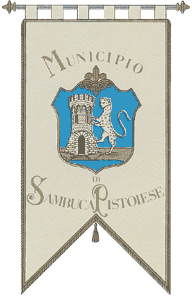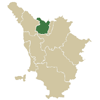|  Inhabitants in 1991: 1.630
Inhabitants in 1991: 1.630
 The
municipal territory of Sambuca Pistoiese, in the Tosco-Emiliano Appennino
between the high Valle del Reno and that in which flows the river Limentra,
extends for 77,54 square kilometres. Feudal centre, then Podesta office,
with the Leopoldine reforms it became Seat of the community. The
municipal territory of Sambuca Pistoiese, in the Tosco-Emiliano Appennino
between the high Valle del Reno and that in which flows the river Limentra,
extends for 77,54 square kilometres. Feudal centre, then Podesta office,
with the Leopoldine reforms it became Seat of the community.
The Sambuca castle together with the Court of Pavana, was
part, from the X century, of the dominion of the Pistoia Episcopate,
as is shown in an Imperial certificate of Ottone III from 997,
even though dependent to the Diocese of Bologna. A guard post of the valley
on the most important road connection between Pistoia and the Padana
valley (the Via Francesca of the Hill), the fort, of which today remain
only some of the wall and one tower, for a long time represented an
outpost of notable strategic importance for the defence against the
Bolognese attacks, who in 1204 taking advantage of the war between
the Fiorentini and the Pistoiese occupied it. Returning as possession
of the Episcopate, Sambuca was ceded in feudal to the Counts of Panico
(1223) and in 1256 the Bishop Guidaloste Vergiolesi invested his own family
there. In 1309 it was sold to the municipality of Pistoia by Lippo
Vergiolesi, father of Selvaggia celebrated by Cino da Pistoia, for
11,000 lire. After having fallen into the hands of Filippo Tedici (1324)
and then Castruccio Castracani, it was conquered in the middle of the
XIV century by the Visconti of Milano (who were recently also made
Lords of Bologna) and who established a fixed garrison in the fort of
Pavana, until then possession of Cantagallo. The Visconti occupation lasted
until 1360 when the Pistoiesi with a surprise attack took over possession,
allowing the diocese to exercise its own ancient rights. From 1375 however
a Fiorentino contingent resided there and it became definitive part
of the Fiorentino State after the annexation of Pistoia as
centre dependent on the Captaincy of the Pistoiese Mountains (even though
they underwent repeated attacks and invasions in the following centuries).
Historical info reproduced upon authorization of Regione Toscana - Dipartimento della Presidenza E Affari Legislativi e Giuridici
Translated by Ann Mountford |